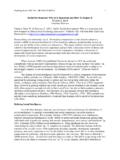Transcription of New European Interoperability Framework
1 New European Interoperability FrameworkPromoting seamless services and data flows for European public administrationsNeither the European Commission nor ant person acting on behalf of the Commission is responsible for the use wich might be made of the following Direct is a service to help you find answers to your questions about the European Union. Freephone number (*):00 800 6 7 8 9 10 11(*) The information given is free, as are most calls (though some operators, phone boxes or hotels may charge you).More information on the European Union is available on the Internet ( )Luxembourg: Publications Office of the European Union, 2017 European Union, 2017 Cover image: Closeup of unfinished jigsaw puzzle, tadamichi, Adobe Stock, 2017 Reproduction is authorised provided the source is acknowledged. Printed in Belgiumprinted on elemental chlorine-free bleached paper (ecf)ISBN 978-92-79-63756-8 Introduction | 3 TABLE OF FIGURESF igure 1: Relationship between EIF, NIFs and DIFs 7 Figure 2: Interoperability principles 10 Figure 3: Interoperability model 22 Figure 4: Conceptual model for integrated public services 34 Figure 5: EIF conceptual model relations 44 CONTENTS1.
2 Introduction Definitions The EIF s purpose and legal Framework Scope, readership and usage of the EIF 62. Underlying principles of European public services Introduction Underlying principle 1: subsidiarity and proportionality Underlying principle 2: openness Underlying principle 3: transparency Underlying principle 4: reusability Underlying principle 5: technological neutrality and data portability Underlying principle 6: user-centricity Underlying principle 7: inclusion and accessibility Underlying principle 8: security and privacy Underlying principle 9: multilingualism Underlying principle 10: administrative simplification Underlying principle 11: preservation of information Underlying principle 12: assessment of effectiveness and efficiency 203.
3 Interoperability layers Interoperability governance integrated public service governance Legal Interoperability Organisational Interoperability Semantic Interoperability Technical Interoperability 304. The conceptual model for integrated public services provision Introduction Model overview Basic components 355. Conclusion 436. Annex Abbreviations IntroductionAs stipulated in the Treaties of the European Union (EU), the EU s internal market guarantees four freedoms - the free movement of goods, capital, services and people between the 28 Member States. These freedoms are assured by common policies supported by interconnected, interoperable networks and systems. People are free to work and relocate and businesses are free to trade and operate in all EU Member States. In doing so, they inevitably have to interact electronically with Member State public make these interactions efficient, effective, timely and of high quality, and to help cut red-tape and reduce the cost and effort involved, Member States are modernising their public administrations by introducing digital public services.
4 However, in doing so, they risk creating isolated digital environments and consequently electronic barriers that may prevent public administrations from connecting with each other, and citizens and businesses from identifying and using available digital public services in countries other than their own. For this reason, efforts to digitise the public sector should be well coordinated at European and national levels to avoid digital fragmentation of services and data, and help the EU s digital single market to work smoothly. At the same time, the challenges facing the Union require common policy responses from the Member States and the Commission, through EU legislation that requires interaction across borders and policy sectors. This also involves setting up and running interoperable systems. Such systems, as set out in the digital single market strategy1, are intended to ensure effective communication between digital components such as devices, networks and data repositories.
5 They also provide more efficient connections across borders, between communities and between public services and EIF gives guidance, through a set of recommendations, to public administrations on how to improve governance of their Interoperability activities, establish cross-organisational relationships, streamline processes supporting end-to-end digital services, and ensure that existing and new legislation do not compromise Interoperability efforts. 4 | New Interoperability Framework for European Public Services1 COM(2015) 192 final, Communication from the Commission to the European Parliament, the Council, the European Economic and Social Committee and the Committee of the Regions - A Digital Single Market Strategy for Europe, Brussels, Introduction | InteroperabilityFor the purpose of the EIF, Interoperability is the ability of organisations2 to interact towards mutually beneficial goals, involving the sharing of information and knowledge between these organisations, through the business processes they support, by means of the exchange of data between their ICT European public serviceA European public service comprises any public sector service exposed to a cross-border dimension and supplied by public administrations.
6 Either to one another or to businesses and citizens in the European Interoperability frameworkThe European Interoperability Framework is a commonly agreed approach to the delivery of European public services in an interoperable manner. It defines basic Interoperability guidelines in the form of common principles, models and The EIF s purpose and legal frameworkThe purpose of the EIF is to: inspire European public administrations in their efforts to design and deliver seamless European public services to other public administrations, citizens and businesses which are to the degree possible, digital-by-default ( providing services and data preferably via digital channels), cross-border-by-default ( accessible for all citizens in the EU) and open-by-default ( enabling reuse, participation/access and transparency); provide guidance to public administrations on the design and update of national Interoperability frameworks (NIFs), or national policies, strategies and guidelines promoting Interoperability .
7 Contribute to the establishment of the digital single market by fostering cross-border and cross-sectoral Interoperability for the delivery of European public main challenge now is to guarantee the secure & free flow of data, develop standards & ensure interoperabilityAndrus AnsipVice-President of the European Commission for the Digital Single Market2 Organisations here means public administration units or any entity acting on their behalf, or EU institutions or | New Interoperability Frameworak for European Public ServicesThe lack of Interoperability is a major obstacle to progress on the digital single market. Using the EIF to steer European Interoperability initiatives contributes to a coherent European interoperable environment, and facilitates the delivery of services that work together, within and across organisations or EIF is principally promoted and maintained by the ISA programme3 in close cooperation between the Member States and the Commission in the spirit of Articles 26, 170 and 171 of the Treaty on the Functioning of the European Union4 calling for the establishment of interoperable trans- European networks that will enable citizens to derive full benefit from a European internal Scope, readership and usage of the EIFThe EIF is meant to be a generic Framework applicable to all public administrations in the EU.
8 It lays out the basic conditions for achieving Interoperability , acting as the common denominator for relevant initiatives at all levels including European , national, regional and local, embracing public administrations, citizens and businesses. This document is addressed to all those involved in defining, designing, developing and delivering European public Member States have different administrative and political systems, national specificities have to be taken into account when transposing the EIF into the national context. EU and national policies ( NIFs) are expected to build upon the EIF, by adding new or fine-tuning existing elements. In a similar way, domain-specific Interoperability frameworks (DIFs)5 should remain compatible with, and where necessary extend, the scope of the EIF to capture the specific Interoperability requirements of the domain in question. This means that some of the EIF elements can be directly copied into a NIF or DIF, while others might need to be contextualised and further tailored to cover the particular relationship among EIF, NIFs and DIFs is described in figure 1.
9 The EIF provides a common core of Interoperability elements to European NIFs and DIFs. Compliance with the EIF guarantees that NIFs and DIFs are developed in a coordinated and aligned way while providing the necessary flexibility to address specific requirements coming from national or domain-specific EIF gives guidance, through a set of recommendations, to public administrations3 Established by Decision (EU) 2015/2240 of the European Parliament and of the Council of 25 November :12012E/TXT&from= For example Directive 2007/2/EC establishing an Infrastructure for Spatial Information in the European Community (INSPIRE), and the relevant implementing regulations and guidelines. Introduction | 7 Figure 1 Relationship between EIF, NIFs and DIFsIn general, the EIF provides value in two directions: bottom-up: when a NIF aligned with the EIF is used for the implementation of public services at all levels of national administrations, it creates the Interoperability conditions for extending the scope of these services across borders.
10 Top-down: when the EIF is considered in EU legislation and policy domains, either through ad hoc references or more structurally using DIFs, it increases the Interoperability potential of the follow-up national actions resulting from both cases, the end result is the development of a European public services ecosystem in which owners and designers of systems and public services become aware of Interoperability requirements, public administrations are ready to collaborate with each other and with businesses and citizens, and information flows seamlessly across borders to support a digital single market in Interoperability areasThe EIF s scope covers three types of interactions: A2A (administration to administration), which refers to interactions between public administrations ( Member State or EU Institutions); A2B (administration to business), which refers to interactions between public administrations (in a Member State or an EU Institution) and businesses; A2C (administration to citizen), which refers to interactions between public administrations (in a Member State or an EU institution) and citizens.















